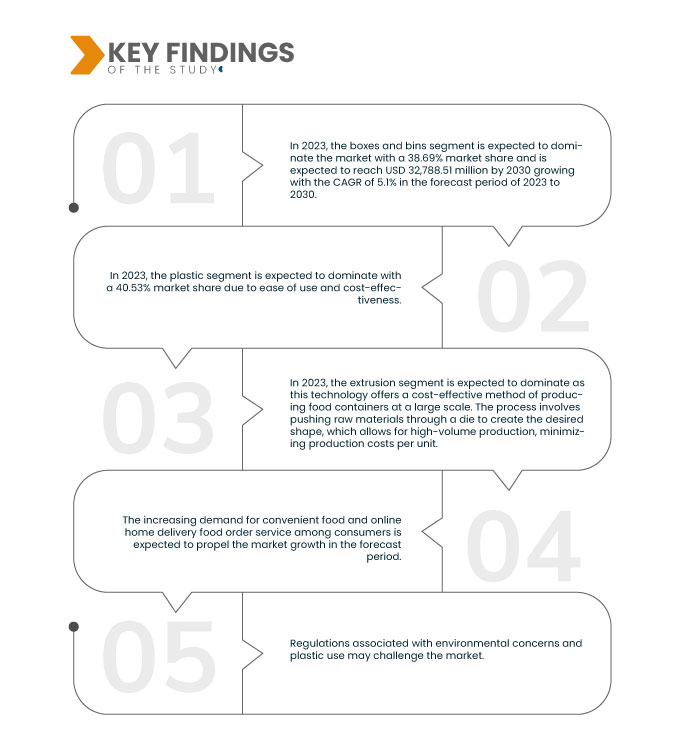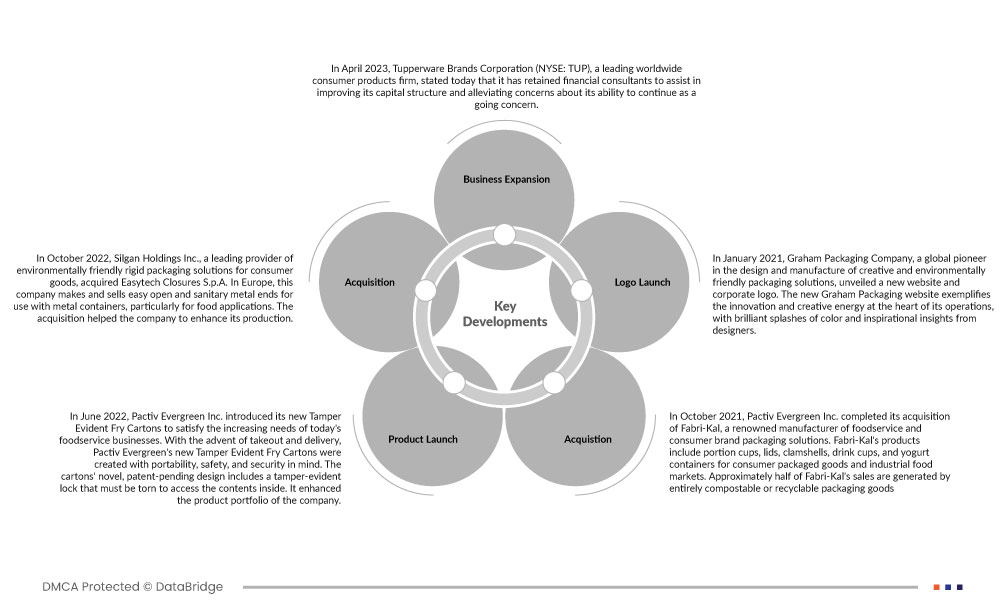Food storage container is a specially designed container used to store and preserve various types of food items for extended periods. These containers come in a variety of materials such as glass, stainless steel, and silicone, and they are equipped with airtight seals to maintain freshness and prevent spoilage of the stored food. In industrial B2C (Business-to-Consumer) applications, food storage containers are widely used by retail companies that cater directly to end consumers. They are a popular kitchen accessory for households, enabling individuals to store leftovers, meal preps, and perishable items in a convenient and organized manner.
Access Full Report @ https://www.databridgemarketresearch.com/reports/europe-us-and-japan-food-storage-container-market
In addition, in the B2B (Business-to-Business) segmentations, food storage containers play a crucial role in the food service industry. Restaurants, cafes, catering companies, and other food-related businesses rely heavily on these containers for efficient food storage and transport. The B2B market demand is largely driven by the need for durable, leak-proof, and stackable containers that meet food safety standards.
Data Bridge Market Research analyses that the Europe, U.S. and Japan Food Storage Container Market is expected to grow at a CAGR of 5.1% in the forecast period of 2023 to 2030 and is expected to reach USD 84,571.14 million by 2030. The rising demand of convenience foods are propelling the Europe, U.S., and Japan food storage container market.
Key Findings of the Study
Rising Demand or Convenience Food Items is Expected to Drive the Market
Convenience has become a key factor influencing consumer behaviour in the food industry. People are increasingly turning to ready-to-eat and easy-to-prepare convenience food items with changing lifestyles, urbanization, and busier schedules. This trend has given rise to significant demand for food storage containers in markets such as Europe, U.S., and Japan. These containers play a crucial role in preserving the freshness and quality of convenience food, ultimately contributing to the growth of the market.
Modern consumers, particularly in Europe, the U.S., and Japan, are leading fast-paced lives, often juggling work, family, and social commitments. Therefore, there is a growing preference for quick and easily accessible food options. In addition, urbanization has led to smaller living spaces and an increase in single-person households. This demographic shift has driven the demand for portion-sized and ready-to-eat meals, leading to higher consumption of convenience food.
For instance,
- In June 2021, according to a research article published in the global media journal, the researchers discovered that convenience functions as a multidimensional construct that promotes consumer comfort. Convenience in the food setting was associated with the reduction of time, physical effort, and mental effort required to purchase, prepare, and eat foods, as well as clean the kitchen.
Convenient foods require proper storage to maintain their taste, texture, and nutritional value. Food storage containers help prevent spoilage, freezer burn, and contamination, ensuring that convenience foods remain appealing and safe to consume. Many convenience food items come in larger quantities than a single serving. Food storage containers allow consumers to divide and store these items into manageable portions, reducing wastage and ensuring food remains fresh until consumed. Modern food storage containers are designed to be microwave and freezer-safe. This feature enhances the convenience of reheating and preserving convenience food, aligning with consumer preferences for quick and hassle-free meal solutions.
The rising demand for convenience food items in Europe, U.S., and Japan has triggered substantial growth in the food storage container market. These containers play a pivotal role in preserving the quality and freshness of convenience foods while offering features that align with the fast-paced lifestyles of consumers. Manufacturers are expected to keep innovating, as the trend towards convenience continues, driving further expansion in this market segment.
Report Scope and Market Segmentation
|
Report Metric
|
Details
|
|
Forecast Period
|
2023 to 2030
|
|
Base Year
|
2022
|
|
Historic Years
|
2021 (Customizable to 2015 – 2020)
|
|
Quantitative Units
|
Revenue in USD Million
|
|
Segments Covered
|
Product (Boxes and Bins, Jars and Canister, Cups and Tubs, Cans, and Bottles), Type (Dry Storage, Fridge Storage Ware, Cookware, Ovenware, Microwave-Ware, Serving Utensils, Freezer-Ware, and Baking Utensils), Material Type (Plastic, Metal, Paper, Glass, Acrylic, Ceramic, Silicone, and Others), Purpose (Airtight Container, Microwave Compatible, and Others), Shape (Round, Square, Rectangle, Oval, and Others), Capacity (501-1000 ML, 1000-1500 ML, 1500-2000 ML, More than 2000 ML, 101-500 ML, and Less than 100 ML), Technology (Extrusion, Injection Molding, Thermoforming, Stretch Blow Molding, and Others), Appearance (Transparent and Colored), Function (Storage, Conveying & Transport, and Picking & Handling), Application (B2C and B2B)
|
|
Countries Covered
|
U.S., Japan, Germany, France, U.K., Italy, Netherlands, Turkey, Spain, Belgium, Russia, Poland, Switzerland, Sweden, Denmark, and Rest of Europe
|
|
Market Players Covered
|
Silgan Holdings (U.S.), Tupperware Brands Corp (U.S.), Pactiv Evergreen Inc. (U.S.), Newell Brands (U.S.), The Clorox Company (U.S.), Graham Packaging Company (U.S.), Anchor Glass Container Corporation (U.S.), EMSA GmbH (Germany), OXO ((U.S.), Locknlock Co (Republic of Korea), Lindar Corp (U.S.), Molded Fiber Glass Tray Company (U.S.), Lenox Corporation (U.S.), Thermos L.L.C. (U.S.), CL Smith (U.S.), Inno-Pak (U.S.), Glasslock USA (U.S.), Freshware (U.S.), and Vremi (U.S.) among others
|
|
Data Points Covered in the Report
|
In addition to the insights on market scenarios such as market value, growth rate, segmentation, geographical coverage, and major players, the market reports curated by the Data Bridge Market Research also include depth expert analysis, patient epidemiology, pipeline analysis, pricing analysis, and regulatory framework.
|
Segment Analysis:
The Europe, U.S. and Japan food storage container market is segmented into ten notable segments which are based on product, type, material type, purpose, shape, capacity, technology, appearance, function, and application.
- On the basis of product, the Europe, U.S. and Japan food storage container market is segmented into boxes and bins, jars and canister, cups and tubs, cans, and bottles.
In 2023, the boxes and bins segment is expected to dominate the Europe, U.S. and Japan food storage container market.
In 2023, the boxes and bins segment is expected to have the largest market share of 38.69% due to higher demand and applicability in the consumer sector.
- On the basis of type, the market is segmented into dry storage, fridge storage ware, cookware, ovenware, microwave-ware, serving utensils, freezer-ware, and baking utensils.
In 2023, the dry storage segment is expected to dominate the Europe, U.S. and Japan food storage container market.
In 2023, the dry storage segment is expected to dominate the market with market share of 24.50% due to ease of use and a wide range of applicability in terms of food storage, packaging, and transportation.
- On the basis of material type, the Europe, U.S. and Japan food storage container market is segmented into plastic, metal, paper, glass, acrylic, ceramic, Silicone, and others. In 2023, the plastic segment is expected to dominate the market with 40.53% market share.
- On the basis of purpose, the Europe, U.S. and Japan food storage container market is segmented into airtight container, microwave compatible, and others. In 2023, the airtight container segment is expected to dominate the market with 56.49% market share.
- On the basis of shape, the Europe, U.S. and Japan food storage container market is segmented into round, square, rectangle, oval, and others. In 2023, the round segment is expected to dominate the market with 37.90% market share.
- On the basis of capacity, the Europe, U.S. and Japan food storage container market is segmented into 501-1000 ml, 1000-1500 ml, 1500-2000 ml, more than 2000 ml, 101-500 ml, and less than 100 ml. In 2023, 501-1000 ml segment is expected to dominate the market with 28.09% market share.
- On the basis of technology, the Europe, U.S. and Japan food storage container market is segmented into extrusion, injection molding, thermoforming, stretch blow molding, and others. In 2023, the extrusion segment is expected to dominate the market with 41.58% market share.
- On the basis of appearance, the Europe, U.S. and Japan food storage container market is segmented into transparent and colored. In 2023, the transparent segment is expected to dominate the market with 77.49% market share.
- On the basis of function, the Europe, U.S. and Japan food storage container market is segmented into storage, conveying & transport, and picking & handling. In 2023, the storage segment is expected to dominate the market with 51.87% market share.
- On the basis of application, the Europe, U.S. and Japan food storage container market is segmented into B2C and B2B. In 2023, B2C segment is expected to dominate the Europe, U.S. and Japan food storage container market with 58.73% market share.
Major Players
Data Bridge Market Research recognizes the following companies as the major market players in Europe, U.S. and Japan food storage container market are Silgan Holdings (U.S.), Tupperware Brands Corp (U.S.), Pactiv Evergreen Inc. (U.S.), Newell Brands (U.S.), The Clorox Company (U.S.), Graham Packaging Company (U.S.), Anchor Glass Container Corporation (U.S.), EMSA GmbH (Germany), OXO ((U.S.), Locknlock Co (Republic of Korea), Lindar Corp (U.S.), Molded Fiber Glass Tray Company (U.S.), Lenox Corporation (U.S.), Thermos L.L.C. (U.S.), CL Smith (U.S.), Inno-Pak (U.S.), Glasslock USA (U.S.), Freshware (U.S.), and Vremi (U.S.) among others.
Recent Developments
- In April 2023, Tupperware Brands Corporation (NYSE: TUP), a leading worldwide consumer products firm, stated today that it has retained financial consultants to assist in improving its capital structure and alleviating concerns about its ability to continue as a going concern.
- In October 2022, Silgan Holdings Inc., a leading provider of environmentally friendly rigid packaging solutions for consumer goods, acquired Easytech Closures S.p.A. In Europe, this company makes and sells easy open and sanitary metal ends for use with metal containers, particularly for food applications. The acquisition helped the company to enhance its production.
- In June 2022, Pactiv Evergreen Inc. introduced its new Tamper Evident Fry Cartons to satisfy the increasing needs of today's foodservice businesses. With the advent of takeout and delivery, Pactiv Evergreen's new Tamper Evident Fry Cartons were created with portability, safety, and security in mind. The cartons' novel, patent-pending design includes a tamper-evident lock that must be torn to access the contents inside. It enhanced the product portfolio of the company.
- In October 2021, Pactiv Evergreen Inc. completed its acquisition of Fabri-Kal, a renowned manufacturer of foodservice and consumer brand packaging solutions. Fabri-Kal's products include portion cups, lids, clamshells, drink cups, and yogurt containers for consumer packaged goods and industrial food markets. Approximately half of Fabri-Kal's sales are generated by entirely compostable or recyclable packaging goods.
- In January 2021, Graham Packaging Company, a global pioneer in the design and manufacture of creative and environmentally friendly packaging solutions, unveiled a new website and corporate logo. The new Graham Packaging website exemplifies the innovation and creative energy at the heart of its operations, with brilliant splashes of color and inspirational insights from designers.
Regional Analysis
Based on geography, the market is segmented into one geographical regions and two countries, Europe, U.S., and Japan. Europe is further segmented into major countries such as the U.K., Turkey, Germany, Netherlands, France, Italy, Poland, Spain, Russia, Belgium, Sweden, Switzerland, Denmark, and Rest of Europe.
As per Data Bridge Market Research analysis:
- Europe is the dominant region in Europe, U.S. and Japan food storage container market
Europe is expected to dominate the market with a significant growth rate and a highest market share due to the presence of a large number of operating major players in the region and the increase in initiatives such as acquisitions, collaborations and product launch by manufacturers to distribute their products efficiently to the consumer.
Japan is the highest growing country in Europe, U.S. and Japan food storage container market during the forecast period 2023-2030
Japan is the highest growing country in the Europe, U.S. and Japan food storage container market due to the presence of a large number of consumer and ongoing opportunities in the country.
For more detailed information about the Europe, U.S. and Japan food storage container market report, click here – https://www.databridgemarketresearch.com/reports/europe-us-and-japan-food-storage-container-market












